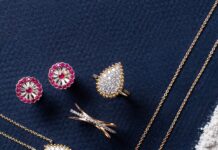Debbie Azar, President and Co-founder of Gemological Science International (GSI): Last May, I wrote a Memo about the need for full disclosure on grading reports issued by gemological laboratories when it comes to post-growth treatments of laboratory-grown diamonds. That has not changed. What is changing is an emerging pattern of “undisclosed” natural diamonds being mixed with laboratory-grown diamonds in jewellery. It is a new and different conversation to have around disclosures, testing, and ethics.
All laboratory-grown diamonds submitted to us for certification go through a specific, controlled process. In the past several months during our routine grading of laboratory-grown diamond jewellery, our team of experts have come across natural diamond melee mixed into lab-grown diamond jewellery on numerous occasions. Laboratory-grown diamond jewellery with “undisclosed” natural diamonds is a new occurrence that we are starting to see with more frequency.
As an industry, we have trained our focus on the undisclosed laboratory-grown diamonds and their detection, especially melee. It is counterintuitive to think about natural diamonds being mixed in with laboratory-grown diamonds. As an industry what do we do about it?
Some may argue that a consumer buying a piece of laboratory-grown diamond jewellery is getting an “upgrade” if they have a few natural diamonds sprinkled in with their laboratory-grown diamonds. But what if that consumer does not want natural diamonds?
We generally base disclosure around value (just the like FTC Guidelines do). If something costs less, it is worthless. If something is worthless, it should not be represented as something worth more. It is Consumer Protection 101. But what if a laboratory-grown diamond is worth more to that customer because of the perceived social or economic impacts? (I am not making the case for or against laboratory-grown or natural diamonds here, just making a case for perceived value.) What if a jewellery-buyer truly does not want a natural diamond?
Think of it like buying leather shoes. If a shoe-buyer prefers leather, and they find out it is synthetic leather, they would be understandably upset. If a shoe-buyer prefers leather but buys synthetic leather shoes because of the price point, then later discovers their shoes were genuine leather, they would see it as a bonus. If a vegan shoe-buyer buys synthetic leather shoes then finds out they are leather, they would be upset. It is not for us to decide what the consumer prefers, but rather, our responsibility to disclose fully what they are considering buying so they can make a clear, informed choice.
I maintain that it is absolutely necessary for retailers to have a process in place to ensure that the diamonds and jewellery they are selling are accurately represented to the consumer. That’s why we have decided to expand our jewellery screening and testing services to include lab-grown diamond jewellery and will continue to report on emerging trends in the detection of laboratory-grown diamond jewellery. As consumers ask for more transparency, we are charged with providing robust, clear reporting that ensures their trust and upholds the standards of our industry.




























